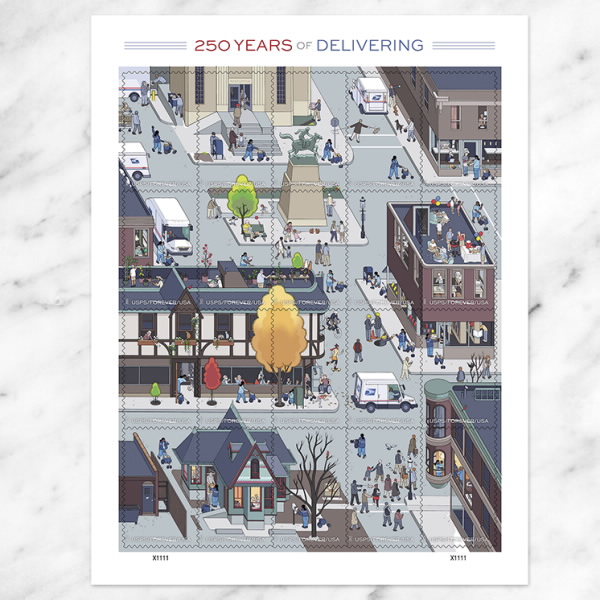-
250 Years of Delivering by Chris Ware
This sheet of United States postal stamps, tell a story across four seasons. Creating by Chris Ware, it contains his iconic geometric illustration style.

-
Tunnel girl
A northern Virginia woman, known on the Internet as “Tunnel Girl,” or Engineer Everything, is constructing a massive underground tunnel below her house.
You’ll find her on TikTok detailing her process and journey.
-
Wi-Fi measuring heartbeats
Apparently, there is a way for Wi-Fi to measure heart rate with clinical accuracy.
Traditionally, measuring heart rate requires some sort of wearable device, whether that be a smart watch or hospital-grade machinery. But new research from engineers at the University of California, Santa Cruz, shows how the signal from a household WiFi device can be used for this crucial health monitoring with state-of-the-art accuracy—without the need for a wearable.
Their proof of concept work demonstrates that one day, anyone could take advantage of this non-intrusive WiFi-based health monitoring technology in their homes. The team proved their technique works with low-cost WiFi devices, demonstrating its usefulness for low resource settings.
-
AI teaches college English
A long but insightful article where a college English professor allowed students to use ChatGPT for assignments. What makes the usage interesting is that he encouraged to evaluate and compare human centered writing versus the AI output. In the end, still began to critically evaluate how to use a technology.
There are valid reasons why college students in particular might prefer that AI do their writing for them: most students are overcommitted; college is expensive, so they need good grades for a good return on their investment; and AI is everywhere, including the post-college workforce. There are also reasons I consider less valid (detailed in a despairing essay that went viral recently), which amount to opportunistic laziness: if you can get away with using AI, why not?
It was this line of thinking that led me to conduct an experiment in my English classroom. I attempted the experiment in four sections of my class during the 2024-2025 academic year, with a total of 72 student writers. Rather than taking an “abstinence-only” approach to AI, I decided to put the central, existential question to them directly: was it still necessary or valuable to learn to write? The choice would be theirs. We would look at the evidence, and at the end of the semester, they would decide by vote whether A.I. could replace me.
-
The complete Ansel Adams
Widely known for his landscape, photography, Ansel Adams took amazing photos, regardless of the subject matter and location. The photos still contain his trademark composition and contrast techniques.
-
Competitive jigsaw puzzle solving
Sometimes, as they say, the algorithm delivers. In this case, a YouTube video of competitive jigsaw puzzle solving popped up from one of the more well known puzzlers, Karen Puzzles.
There is a surprising intensity to the competition, especially when the competitors are near completion and each only have a dozen or so pieces left. As a sport, and provide plenty of material for ESPN quality commentary – history of competitors, techniques, and more.
In the below video, she attempts to do a speed run of a 5000 piece puzzle, breaking down strategies and approaches for competitive jigsaw puzzle solving.
-
Depression and circadian rhythm link
An interesting possibility: depression may be linked to circadian rhythms being out of sync. The study had a small sample size so obviously more research is needed.
The study, led by Dr Joanne Carpenter and Professor Ian Hickie from the University of Sydney, is the first to look simultaneously at three key measures of body clock regulation in people with mental ill-health.
“We analysed participants’ core body temperature, cortisol levels and melatonin levels, which we know play important roles in how our bodies manage the circadian rhythm – our 24-hour cycles which regulate things like wakefulness and sleep,” said Dr Carpenter, a Research Fellow at the Faculty of Medicine and Health Central Clinical School and member of the Brain and Mind Centre’s Youth Mental Health and Technology Group.
-
Cats and water
Most cats don’t like water, and there are reasons for that. Some evolutionary, some biological.
-
Moving on from Dr. Seuss?
Still, Seuss dominates so much of our imaginations around childhood. It may take another generation or two to reset our perspective so that Seuss isn’t synonymous with children’s literature. I spoke with Kesi Augustine, PhD, a debut children’s author and scholar whose research focuses on children’s literature to ask for her insights. Recently when Augustine was promoting her picture book, Faith Takes the Train (HarperCollins 2025, illustrated by Mokshini), an adult reader approached her before she had even started her event.
The reader asked if she was a children’s author, and related that Green Eggs and Ham was his all-time favorite book. As he and Augustine engaged in a conversation about Seuss, Augustine observed the powerful nostalgia that can cast a spell on us for decades, preventing us from discovering new authors. Isn’t 65 years of Green Eggs and Ham enough? What new books will become beloved for generations?
-
Art History hidden in Travis Kelce and Taylor Swift’s engagement photos
There are too many coincidences for this not to be intentional, but some of these are not commonly referenced artworks. Art historians found numerous references to classical paintings in Travis Kelce and Taylor Swift’s engagement photos.
